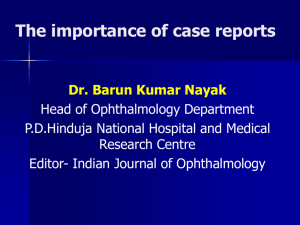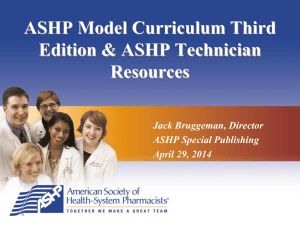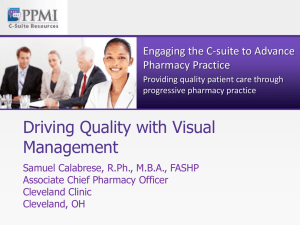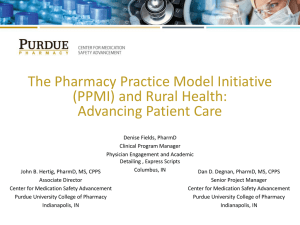Drug_Information_Cen..
advertisement
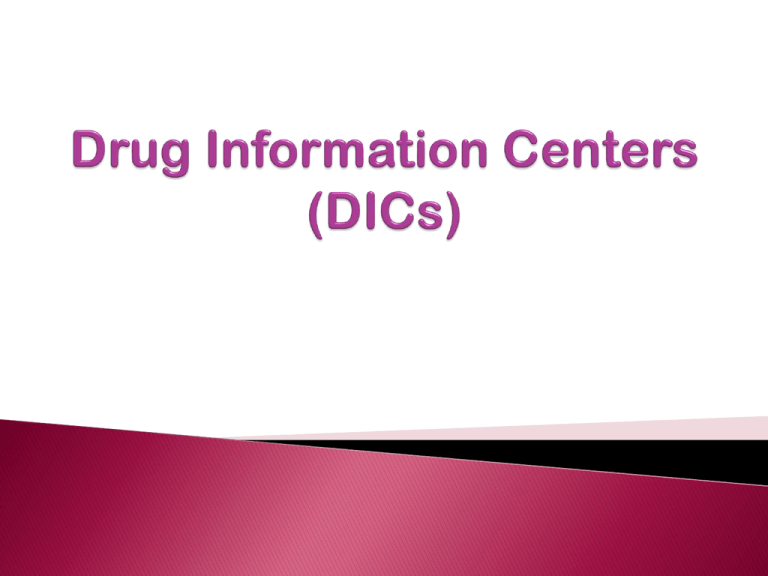
Define drug information and related terms History of drug information Drug information center goals ASHP effective provider of drug information The pharmacist role Considerations of DIC Systematic method for responding to requests Documentation and quality assessment of drug information requests Drug Information is the provision of unbiased, wellreferenced, and critically evaluated information on any aspect of pharmacy practice Drug Information Center is to provide a system for the organization and dissemination of drug information (Francke 1965) Drug Informatics emphasizes the use of technology as an integral tool in effectively organizing, analyzing and managing information on medications Yousif Abdu Asiri, The Difference Between Drug Information Center (DIC) and Poison Control Center (PCC).Power Point Presentation 1960s Development of the term ‘’drug information’’ 1962 First drug information center at the University of Kentucky Medical Center, USA 1964 Conference on Drug Information Services 1967 The ‘’Drug Information Specialist’’ 1975 The Millis Commission Report, AACP described the main function of pharmacists as providers of drug information Yousif Abdu Asiri, The Difference Between Drug Information Center (DIC) and Poison Control Center (PCC).Power Point Presentation To stimulate the effective use of drug information resources by pharmacists, physicians, and other health care professionals To educate pharmacy students to serve as effective providers of drug information To provide an organized database of specialized information on drug therapeutics to meet the drug information needs of practitioners To expand the role of the pharmacist in providing drug information services to the hospital and community To promote patient care through rational drug therapy by the improved availability and use of drug information 1. Perceive and evaluate the medication information needs of patients and families, health care professionals, and other personnel ASHP, Am J Health-Syst Pharm. 1996; 53:1843–5 2. Use a systematic approach to address medication information needs by effectively: ◦ ◦ ◦ ◦ ◦ Searching literature Retrieving literature Evaluating literature Appropriately communicating information Applying the information to the patient care situation ASHP, Am J Health-Syst Pharm. 1996; 53:1843–5 1. Providing medication information to patients & families, health care professionals, and other personnel 2. Establishing and maintaining a formulary based on scientific evidence of efficacy and safety, cost, and patient factors 3. Developing and participating in efforts to prevent medication misadventuring, including adverse drug event and medication error reporting and analysis programs ASHP, Am J Health-Syst Pharm. 1996; 53:1843–5 4. Developing methods of changing patient and provider behaviors to support optimal medication use 5. Publishing newsletters to educate patients, families, and health care professionals on medication use 6. Educating providers about medication-related policies and procedures ASHP, Am J Health-Syst Pharm. 1996; 53:1843–5 7. Coordinating programs to support population based medication practices (e.g. development of medicationuse evaluation criteria and pharmacotherapeutic guidelines) 8. Coordinating investigational drug services 9. Providing continuing-education services to the healthcare professional staff ASHP, Am J Health-Syst Pharm. 1996; 53:1843–5 10. Educating pharmacy students and residents 11. Applying health economic and outcome analysis 12. Developing and maintaining an active research program ASHP, Am J Health-Syst Pharm. 1996; 53:1843–5 Hospital based Industry based Community based Yousif Abdu Asiri, The Difference Between Drug Information Center (DIC) and Poison Control Center (PCC).Power Point Presentation 1. Telephone: the lines should be designed to allow immediate, direct access to the center 2. Computers 3. Fax machine 4. Printer 5. Copier machine Databases are available for information management, retrieval, and communication Information management databases include software for MUE, documentation of questions and responses, and preparation of reports of adverse drug events Information retrieval sources include bibliographic databases (e.g., International Pharmaceutical Abstracts, Iowa Drug Information Service, MEDLINE) and full-text databases (e.g., Drug Information Fulltext) Textbooks (e.g., AHFS Drug Information) and journals can also be accessed through computer technology Some information is available through electronic bulletin boards (e.g., PharmNet) and the Internet Computerized medical records can also be a valuable tool in assessing either individual patient needs or population-based needs It should be close to the pharmacy department to allow both pharmacy staff & other healthcare providers to reach it easily A sign or label on the door the to specify who will be allowed to enter the DIC room It can be inside the pharmacy department Specific Criteria: ◦ Pharm.D degree, MS degree, BS degree with specialized training in drug information center, experience minimum 1-2 years, residency, fellowship General Criteria : ◦ Computers skills ◦ The person should be cooperative, confident, accurate, good English language Types of Resources: ◦ Tertiary Resources (textbooks, review articles) ◦ Secondary Resources (index and abstract primary resources with the goal of directing user to primary resources) ◦ Primary resources (journals) Not all articles are considered primary resources !!! It is the responsibility of the pharmacist to ensure that up-to-date resources are available Pharmacists should be familiar with not only the components of the literature (e.g. primary) but also the features of individual resources in each component ◦ this makes searching more efficient so that time can be used optimally in analyzing, applying, & communicating the information 1. Consider the education and professional or experiential background of the requester 2. Identify needs by asking probing questions or by examining the medical record to identify the true question. Assess the urgency for a response 3. Classify requests as patient-specific or not and by type of question to aid in assessing the situation and selecting resources ASHP, Am J Health-Syst Pharm. 1996; 53:1843–5 Product availability, Adverse drug event Compatibility Compounding/formulation Dosage/administration Drug interaction Identification Pharmacokinetics therapeutic use/efficacy Safety in pregnancy and nursing Toxicity and poisoning Articles/Reviews 4. Obtain more complete background information, including patient data to individualize the response to meet the patient’s, family’s, or health care professional’s needs 5. Perform a systematic search of the literature by making appropriate selections from the primary, secondary, and tertiary literature 6. Evaluate, interpret, and combine information from the several sources. Other information needs should be anticipated as a result of the information provided ASHP, Am J Health-Syst Pharm. 1996; 53:1843–5 7. Provide a response by written or oral consultation, or both, as needed by the requester and appropriate to the situation 8. Perform a follow-up assessment to determine the utility of the information provided and outcomes for the patient 9. Document the request, information sources, response, and follow-up as appropriate ASHP, Am J Health-Syst Pharm. 1996; 53:1843–5 1. Date and time received 2. Requester’s name, address, method of contact (e.g., telephone or beeper number), and category (e.g., health care discipline, patient, public) 3. Person assessing medication information needs 4. Method of delivery (e.g., telephone, personal visit, mail). 5. Classification of request 6. Question asked 7. Patient-specific information obtained ASHP, Am J Health-Syst Pharm. 1996; 53:1843–5 8. Response provided 9. References used 10. Date and time answered 11. Person responding to request 12. Estimated time in preparation and for communication 13. Materials sent to requesters 14. Outcome measures suggested (e.g., impact on patient care, improvements in medication use, and requester satisfaction) ASHP, Am J Health-Syst Pharm. 1996; 53:1843–5 Responses to requests for medication information should be accurate, complete, and timely for: ◦ maximal clinical usefulness ◦ to establish credibility for pharmacist-provided information ASHP, Am J Health-Syst Pharm. 1996; 53:1843–5 Quality assessment of responses could be selective for: ◦ certain types of patient-specific requests ◦ random by numbers of requests ◦ for certain time periods ASHP, Am J Health-Syst Pharm. 1996; 53:1843–5 It is the responsibility of the pharmacist to keep abreast of advancements both ◦ in the tools that can be used to systematically address information requests And ◦ in the information itself regarding pharmacotherapeutic or other issues affecting the practice of pharmacy ASHP, Am J Health-Syst Pharm. 1996; 53:1843–5
